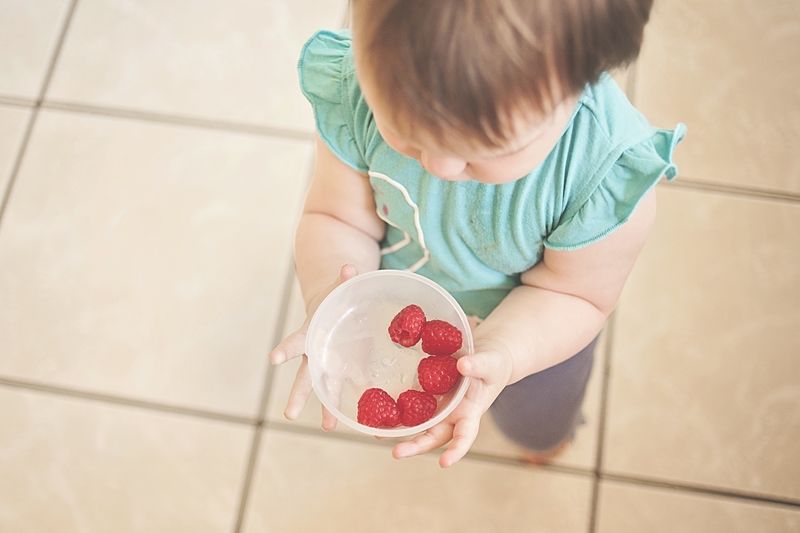
Nichola Whitehead is a registered dietitian and health blogger, we asked her what we should be feeding our young ones, and how we can incorporate the recommended ‘5 a day’ into healthy meal ideas.
Most of us know how important it is to eat a healthy diet, but not many people know that what we eat when we are young, affects our health when we are older too. It’s therefore important to give our children the best start in life by offering them a healthy, balanced and varied diet.
Growing up
Babies usually start weaning (moving from a breast or formula-milk-only diet to one that contains small amounts of food) at around six months old. Foods that parents should avoid at weaning include those that may cause choking such as whole grapes, whole nuts, chunks of cheese and popcorn. Honey should not be given to children until they are at least a year old due to the risk of botulism. You should also avoid adding salt, sweetener and sugar to meals.
Children aged 1 to 3 years should have no more than two grams of salt a day, and those aged 4 to 6 years should have no more than three grams of salt a day. The daily recommended maximum amount of sugar for young children (including table sugar, syrups and the sugar in fresh juice) is 13 grams for 2-year-olds, 15g for three-year-olds and 19g for 4-to-6-year-olds.
Children should ideally eat a mixture of the following different food groups:
• Vegetables and fruit for vitamins, minerals and other plant-based nutrients
• Starchy foods and whole grains for energy and fibre
• Dairy foods such as milk and yoghurt for calcium
• Legumes, eggs, fish, poultry, meat, nuts and seeds for protein and healthy fats
Children’s Meal Times
It’s important to lead by example and offer new foods, alongside familiar foods, within a calm and relaxed environment; ideally at a time when you are eating as well. Children may be over faced at meal times if you give them too much food, which is why you should serve them food on a smaller plate compared to your own; start by serving around half the portion that you would give to an adult and praise your child when they try something new. Older children may respond well to reward charts; for example, they could get a sticker every time they try a new food or eat a portion (handful) of fruit or vegetables.
Incorporating 5 a Day into Meal Times
Getting children to eat the recommended five portions of fruit and vegetables a day can be tricky for some parents, especially if they are dealing with a fussy eater, which is why I’ve come up with the following tips depending on the meal:
• Breakfast: When it comes to breakfast I’m a big fan of giving children choices; for example, what toppings to have on porridge or overnight oats! Both porridge and overnight oats can be made in a batch and can be topped with fruit such as strawberries, blueberries and flaked almonds or even banana and chocolate chips for a sweet treat. You could even mash bananas or strawberries into the porridge after cooking to turn the oats a lovely yellow or pink colour! For a different take on porridge, you could also try my Baked Berry & Banana Oats, which can be sliced up for easy eating with fingers!
• Lunch: If you’re preparing a packed lunch for school, talk about the benefits of the foods such as energy, vitamins, minerals and fibre. Checkout Weelicious on Instagram from some lunch box inspiration!
• Snacks: Children are often hungry after school so make sure to have healthy, easy-to-eat snacks on hand that include fruit and vegetables such as berries and yoghurt, cheese with an apple or tzatziki/hummus with cucumber, pita bread or carrot sticks. You could even have a go at whipping up my oat and apple breakfast bars which can be enjoyed at any time of the day!
• Dinner: The evening meal should (where possible) be eaten as a family to practice table manners and try new foods; with the parents leading by example! I love easy to make one pot dishes such as Shepherd’s Pie as you can add a whole host of different vegetables to the mix or you can even blend it into the tomato sauce; peppers, onion and courgette work well.
• Dessert: More indulgent or sugary desserts should be kept as an occasional treat. A naturally sweet option is to serve banana ice-cream which is a great way of using up ripe bananas!
I hope you’ve found this article useful. For more healthy tips check out the Change 4 Life website.
By Nichola Whitehead – Registered Dietician & Health Blogger at nicsnutrition.com
This articles expresses the views of the author alone and does not necessarily reflect the views of Shepherds Friendly Society.



